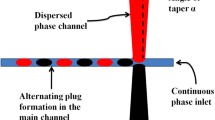Abstract
This study investigates the influence of both local generator design and global network architecture in improving the stability and operational performance of microfluidic droplet generators. We identify naturally occurring short-term and long-term oscillations that are related to changes in the flow of the two phases. Short-term oscillations are related to the creation of each droplet and are quantified by tracking droplet speed in the network. Long-term oscillations are caused by dynamic feedback associated with the periodic change in the hydrodynamic resistance of the network as droplets enter and exit the system. Our analysis identifies that these long-term oscillations are best quantified by measuring changes in droplet spacing rather than the conventional method of using droplet size. Furthermore, we find that these long-term oscillations have a periodicity that matches the residence time of droplets within the network. In combination with experiments, a simple compact model is developed to study these oscillations and guide the network design of droplet generators. As part of this analysis a set of design rules is developed to help improve overall generator performance using pressure-driven flow.










Similar content being viewed by others
References
Barbier V, Willaime H et al (2006) Producing droplets in parallel microfluidic systems. Phys Rev E 74(4):046306
Beer NR, Rose KA et al (2009) Observed velocity fluctuations in monodisperse droplet generators. Lab Chip 9(6):838–840
Bretherton FP (1961) The motion of long bubbles in tubes. J Fluid Mech 10(2):166–188
Bruus H (2007) Theoretical microfluidics. Oxford University Press, New York
Christopher GF, Anna SL (2007) Microfluidic methods for generating continuous droplet streams. J Phys D 40(19):R319–R336
Christopher GF, Noharuddin NN et al (2008) Experimental observations of the squeezing-to-dripping transition in T-shaped microfluidic junctions. Phys Rev E 78(3):036317
Cybulski O, Garstecki P (2010) Dynamic memory in a microfluidic system of droplets traveling through a simple network of microchannels. Lab Chip 10(4):484–493
de Mas N, Gunther A et al (2005) Scaled-out multilayer gas-liquid microreactor with integrated velocimetry sensors. Ind Eng Chem 44(24):8997–9013
Fuerstman MJ, Lai A et al (2007) The pressure drop along rectangular microchannels containing bubbles. Lab Chip 7(11):1479–1489
Garstecki P, Fuerstman MJ et al (2006) Formation of droplets and bubbles in a microfluidic T-junction—scaling and mechanism of break-up. Lab Chip 6(3):437–446
Glawdel T, Elbuken C et al (2012a) Droplet formation in microfluidic T-junction generators operating in the transitional regime. I. Experimental observations. Phys Rev E 85(1):016322
Glawdel T, Elbuken C et al (2012b) Droplet formation in microfluidic T-junction generators operating in the transitional regime. II. Modeling. Phys Rev E 85(1):016323
Glawdel T, Elbuken C et al (2011) Passive droplet trafficking at microfluidic junctions under geometric and flow asymmetries. Lab Chip 11(22):3774–3784
Hashimoto M, Shevkoplyas SS et al (2008) Formation of Bubbles and Droplets in Parallel. Coupled Flow-Focusing Geometries. Small 4(10):1795–1805
Korczyk PM, Cybulski O et al (2011) Effects of unsteadiness of the rates of flow on the dynamics of formation of droplets in microfluidic systems. Lab Chip 11(1):173–175
Labrot V, Schindler M et al (2009) Extracting the hydrodynamic resistance of droplets from their behavior in microchannel networks. Biomicrofluidics 3:012804
Li W, Young EWK et al (2008) Simultaneous generation of droplets with different dimensions in parallel integrated microfluidic droplet generators. Soft Matter 4(2):258–262
Malsch D, Gleichmann N et al (2010) Dynamics of droplet formation at T-shaped nozzles with elastic feed lines. Microfluidics Nanofluidics 8(4):497–507
Schindler M, Ajdari A (2008) Droplet traffic in microfluidic networks: A simple model for understanding and designing. Phys Rev Lett 100(4):044501
Sessoms DA, Amon A et al (2010) Complex Dynamics of Droplet Traffic in a Bifurcating Microfluidic Channel: Periodicity, Multistability, and Selection Rules. Phys Rev Lett 105(15):154501
Steegmans MLJ, Schroen C et al (2009) Generalised insights in droplet formation at T-junctions through statistical analysis. Chem Eng Sci 64(13):3042–3050
Sullivan MT, Stone HA (2008) The role of feedback in microfluidic flow-focusing devices. Philos T R Soc A 366(1873):2131–2143
Tetradis-Meris G, Rossetti D et al (2009) Novel Parallel Integration of Microfluidic Device Network for Emulsion Formation. Ind Eng Chem 48(19):8881–8889
van Steijn V, Kreutzer MT et al (2008) Velocity fluctuations of segmented flow in microchannels. Chem Eng J 135:S159–S165
van Steijn V, Kleijn CR et al (2009) Flows around Confined Bubbles and Their Importance in Triggering Pinch-Off. Phys Rev Lett 103(21):214501
van Steijn V, Kleijn CR et al (2010) Predictive model for the size of bubbles and droplets created in microfluidic T-junctions. Lab Chip 10(19):2513–2518
Vanapalli SA, Banpurkar AG et al (2009) Hydrodynamic resistance of single confined moving drops in rectangular microchannels. Lab Chip 9(7):982–990
Ward T, Faivre M et al (2005) Microfluidic flow focusing: drop size and scaling in pressure versus flow-rate-driven pumping. Electrophoresis 26(19):3716–3724
Acknowledgments
The authors gratefully acknowledge the support from the Natural Sciences and Engineering Research Council of Canada, Canada Foundation for Innovation of Canada, International Science and Technology Program of Canada and Ontario Centers of Excellence to Dr. Carolyn Ren through her grants, and the Canada Graduate Scholarship to Tomasz Glawdel.
Author information
Authors and Affiliations
Corresponding author
Electronic supplementary material
Below is the link to the electronic supplementary material.
Rights and permissions
About this article
Cite this article
Glawdel, T., Ren, C.L. Global network design for robust operation of microfluidic droplet generators with pressure-driven flow. Microfluid Nanofluid 13, 469–480 (2012). https://doi.org/10.1007/s10404-012-0982-y
Received:
Accepted:
Published:
Issue Date:
DOI: https://doi.org/10.1007/s10404-012-0982-y




